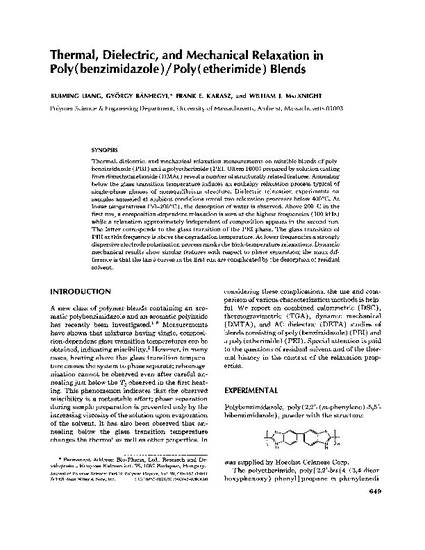
Article
Thermal, Dielectric, and Mechanical Relaxation in Poly(benzimidazole)/Poly(etherimide) Blends
Journal of Polymer Science: Part B: Polymer Physics
(1991)
Abstract
Thermal, dielectric, and mechanical relaxation measurements on miscible blends of poly-
benzimidazole(PBI)and a polyetherimide (PEI, Ultem 1000)prepared by solution casting
from dimethylacetamide (DMAc) reveal a number of structurally related features. Annealing
below the glass transition temperature induces an enthalpy relaxation process typical of
single-phase glasses of nonequilibrium structure. Dielectric relaxation experiments on
samples annealed at ambient conditions reveal two relaxation processes below 400°C.At
lower temperatures (50-2OO0C), the desorption of water is observed. Above 200°C in the
first run, a composition-dependent relaxation is seen at the highest frequencies ( 100 kHz)
while a relaxation approximately independent of composition appears in the second run.
The latter corresponds to the glass transition of the PEI phase. The glass transition of
PBI at this frequency is above the degradation temperature. At lower frequencies a strongly
dispersive electrode polarization process masks the high-temperature relaxations. Dynamic
mechanical results show similar features with respect to phase separation; the main dif-
ference is that the tan 6 curves in the first run are complicated by the desorption of residual
solvent.
Keywords
- thermal,
- dielectric,
- mechanical relaxation,
- poly(benzimidazole)/poly(etherimide),
- blends
Disciplines
Publication Date
1991
Citation Information
William MacKnight, Kuiming Liang, Gyorgy Banhegyi and F. E. Karasz. "Thermal, Dielectric, and Mechanical Relaxation in Poly(benzimidazole)/Poly(etherimide) Blends" Journal of Polymer Science: Part B: Polymer Physics Vol. 29 (1991) p. 649 - 657 Available at: http://works.bepress.com/william_macknight/296/
